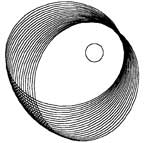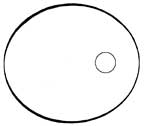A B C
D E F
D. The Law of Gravity
Einstein spent a good deal of time over several years, with
the help of a number of collaborators, typing to work out a mathematical law
that would account for gravity in terms of spacetime curvature, and publishing
various speculations and findings along the way. Other physicists read
these publications and took the ideas in new directions on their own. But
in 1915, Einstein had arrived at a spacetime-curvature law and explained it in a
series of papers that year and the next.
Two clues were particularly important in Einstein's choice
of a curvature law. One was the known accuracy of Isaac Newton's law of
gravity. Much more than "what goes up must come down" (which
Newton's law doesn't imply), Newton found that the acceleration in one
object's motion produced by another object's gravitational attraction is
proportional to the attracting object's mass divided by the square of the
distance between the objects:
attracted object's acceleration =

Acceleration, a speed divided by a time, is measured in
units other than mass divided by distance squared; the " " in the equation is a universal conversion ratio. Since this
law had been proven accurate in many experiments and astronomical observations,
Einstein's curvature law had to give equally accurate results when applied to
the same situations.
" in the equation is a universal conversion ratio. Since this
law had been proven accurate in many experiments and astronomical observations,
Einstein's curvature law had to give equally accurate results when applied to
the same situations.
Einstein also hoped that his new law would explain
something that Newton's law
couldn't. If you apply Newton's law to the motions of planets in the solar
system, you find that the sun's gravity is the main influence on each planet,
while the attractions of the planet's own satellites, and the other planets,
provide a smaller but still significant influence. Just these attractions
account for every feature of planetary motion that astronomers had observed by
the early 20th century—except for one.
Newton's
law implied that, if the sun alone were the only object attracting the planet
Mercury, then Mercury should move in the same orbit over and over indefinitely,
with its closest approach to the sun occurring at the same place every time,
much like the orbit shown in Figure 3:

Figure
3.
while the additional attractions from the other planets
should disturb Mercury's orbit to make it something like this one in Figure 4:

Figure
4.
The effect is exaggerated in Figure 4 to make it
visible: Mercury's orbit isn't as elliptical as the orbit shown, and
Mercury actually has to go around the sun many more times for its closest
approach to the sun to change position by the amount pictured.
Mercury's closest approach to the sun shifts around even
faster—if only slightly faster—than the other planets' attractions can
account for (Figure 5):

Figure
5.
so if we subtract the other planets' attraction, we're
left, not with the eternal orbit of Figure 3, but with a slightly shifting orbit—something that Newton's law doesn't
explain (Figure 6):

Figure
6.
These last two figures also exaggerate. The actual and residual shifts are
much smaller: in 100 years, Mercury's closest approach to the sun moves
around by an angle of 2.78 milliradians (574 arcseconds), which is roughly a
fifth of a milliradian (43 arcseconds) more than the shift caused by other
planets' gravity. One-fifth of a milliradian is the angular width of
one-fifth of a millimeter seen from one meter away, or a similar small width
seen at arm's length. This angle is small, but measurable, and was well
documented by centuries of astronomical observations. Newton's law of
gravity was utterly unable to explain it.
The
equation Einstein eventually proposed took several features of spacetime and
gravity into account. First, to account for gravity's operation in vacuum,
Einstein realized that it should be possible for spacetime to be curved even
when there's nothing in it. Second, spacetime's curvature should be
affected by the presence of matter. Third, as we noted earlier, the
curvature would have to produce paths in spacetime that look like the ones you'd
expect from Newton's law under conditions for which Newton's law is known to be
accurate.
These
requirements didn't define a unique law of curvature, though they did limit the
possible choices. Einstein thus made use of another reasonable
hypothesis. A gravitational field can be thought of as having
energy. Where gravity is stronger, the gravitational field's energy is
denser. Since no natural process produces energy from nothing or turns
energy into nothing, accurate mathematical descriptions of energy can only imply
that energy changes its form or location, never its total amount; at any place
where the density of energy changes, a corresponding flow of momentum moves some
energy in or out. Einstein found an equation that implied spacetime
curvature would have these properties when the spacetime did not contain
matter. He then assumed that the same equation would describe the energy
and momentum within any region of spacetime, even if it did contain
matter. The equation was
G
= 8 πκ T/c4
where
G = the sum of certain components of spacetime curvature,
T = corresponding features of the energy, momentum, and stresses within matter,
κ
= the same universal converstion ratio found in Newton's gravitational law,
c = the speed of light in vacuum.
Since G represents only the sum of certain features of the
curvature of spacetime, there can still be curvature even in the empty space
around matter—for example, approximately what we find
in outer space around the earth. In empty space where there is no matter,
the energy, momentum, and stresses of matter all equal zero, and Einstein's
equation implies that the sum G equals 0. If G represented all the
features of spacetime curvature individually, the absence of matter at any point
would imply the absence of gravity at that point. Gravity in empty space
does exist, though, embodied in other features of spacetime curvature not
included in G. Einstein's equation thus conforms to the first feature of
gravity noted above. The second feature is accounted for as well, since
the remaining aspects of spacetime curvature that G does represent are directly
proportional to the energy, stresses, and momentum flow of any matter occupying
the spacetime. While G and T can represent extremely complex spacetime
curvatures and matter distributions, the relation between them—their proportionality—is a simple one.
Although
it's not immediately obvious, Einstein's equation turns out to conform to
Newton's law as well. When you define a matter distribution whose density
and internal stresses are not extremely high, and whose motions are slow
compared to the speed of light, the straightest possible lines in the
surrounding spacetime are very nearly the orbits that objects would have if
Newton's law were 100% accurate.
In
one respect, though, the orbits aren't quite the same. Einstein found
that, if his equation were correct, any planet whose orbit isn't circular should
move like the one illustrated in Figure 6 if there were no other planets to
influence its motion. A planet in Mercury's situation should gradually
shift its nearest approach to the sun a fifth of a milliradian per century
faster than the rate that Newton's law could account for. Einstein
considered this fact one of the strongest indications that his equation G
= 8 πκ T/c4
was on the right track.
(.....continued)
A B C
D E F








